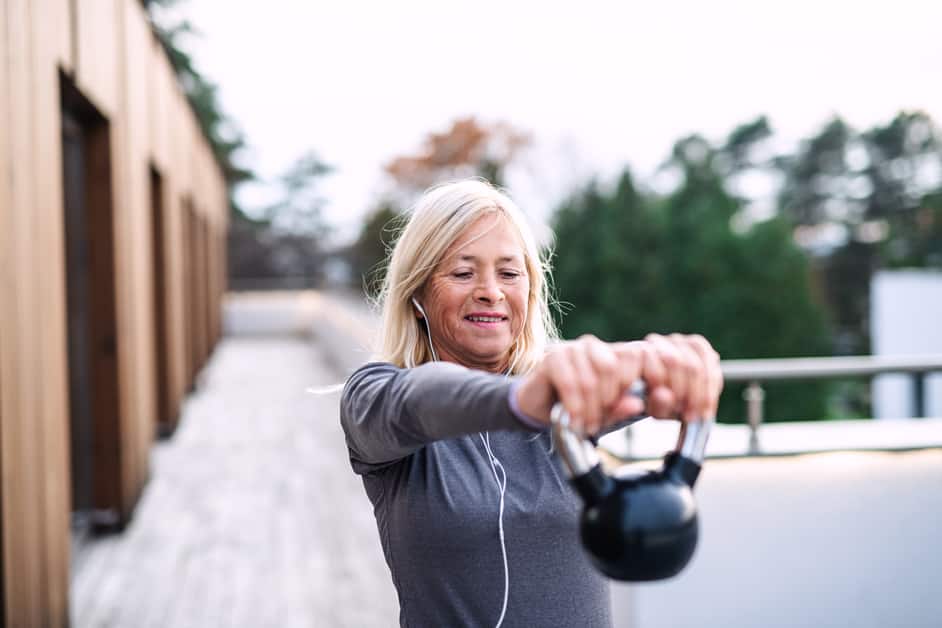Introduction
Knees are essential! Taking care of them is key to having good health and mobility. Kettlebell training can help protect the knees from injuries. It also helps with movement and muscular control of the joint.
Kettlebells work for anyone, no matter age, gender or fitness level. With a few adjustments, anyone can use them for exercises to improve knee health and mobility. Here are five exercises targeting knee flexibility, strength and range of motion:
Kettlebell Swing
Kettlebell swings are awesome for knee joint health and mobility. It’s a dynamic move that strengthens and stretches the lower body muscles, like glutes and hamstrings. Doing swings correctly can help make the knee joint more stable, and increase the power in hips and legs.
The benefits: less chance of knee injuries, plus improved flexibility and range of motion.
Let’s look at how to do this exercise correctly and get the most out of it:
How to Perform
The Kettlebell Swing is a full-body exercise. It is great for knee joint health and mobility. Here are steps to do it right:
- Stand with feet shoulder width apart and hold the kettlebell in front of your thighs.
- Bend your knees and push your hips back like a squat or deadlift. Keep your core tight and engage your glutes.
- Squeeze your glutes and hamstrings explosively to generate power for the kickback.
- Use your core to drive the momentum forward and up, extending both legs without locking out at the knee joint. Bring the kettlebell back up to chest height.
- Repeat desired number of reps. If using lighter weight, focus on form. For heavier weights, get guidance from a professional.
Benefits
Kettlebell swings are an amazing exercise for your knee joint health and mobility. Strength, power and endurance are combined to make this a great way to strengthen your lower body. When done properly, it increases stability, activates your glutes and challenges balance, range of motion, and muscle groups – all to promote flexibility.
Kettlebell swings help you stay injury-free and improve muscle growth, bone density, and core stabilization. Joint stress is reduced when performing other exercises or activities. This exercise also increases hip extension, which is great for your hamstrings and glutes. Additionally, you will obtain faster sprint speeds and improved posture.
In conclusion, kettlebell swings are an awesome addition to any fitness routine. It increases strength while stabilizing and mobilizing your joints. Athletes can get an edge on the field, and anyone can step up their workout!
Kettlebell Goblet Squat
Goblet squat with a kettlebell! This is a great exercise for knee health and mobility. You use a kettlebell as a weight. This targets all muscles around the knee and helps build strength and mobility. Plus, anyone can do it – from beginners to pros.
Let’s learn about the kettlebell goblet squat and its advantages:
How to Perform
The Kettlebell Goblet Squat is perfect for knee joint health and mobility.
- Grasp a kettlebell (based on strength level) with both hands in front of your chest.
- Stand with feet hip width apart, toes slightly outward.
- Lower yourself by pushing hips back and bending knees. Keep back straight and weight evenly distributed. Try to reduce tension on lower back.
- At bottom position, keep elbows pointed downward. Press kettlebell into chest and squeeze shoulder blades together. Hold for moment, then stand up by driving through heels with knees parallel.
- Maintain good form and engage muscle groups, avoiding arching during exercise.
Benefits
Kettlebell goblet squats use time-under-tension to challenge muscles in hips, legs, and core. It builds strength and muscle, boosts mobility and flexibility, and reduces injury risk.
Benefits:
- Improved Hip Mobility: The range of motion increases when you squat holding a kettlebell at chest level.
- Core Strength: Your spine must stay aligned during each rep, strengthening your lats and abs.
- Knee Stability: There’s no load on your back or shoulders, so your knees are safe.
- Posture and Balance: Engaging core muscles improves posture and weight distribution when lifting.
Kettlebell Single-Leg Deadlift
Kettlebell single-leg deadlifts are fab for knee joint health. Multiple muscles get worked simultaneously and balance and stability can improve. When doing this workout, strict form is essential. It’s an advanced exercise so take care. Let’s dive deeper and explore the benefits!
How to Perform
The Single-leg deadlift is an amazing way to improve knee mobility and proprioception. You don’t need to put much weight on your knees or connect them to the floor.
To do this exercise, stand on one foot. Your other foot should be slightly behind you. Bend your front knee slightly and hold a kettlebell in one hand. Reach your opposite arm forward for balance. Lean at the hip while keeping a straight back. Keep your locker straight and use the kettlebell to lift your body as high as you can, with just one leg on the ground. Remember, your chest should be proud and eyes focused forward.
When lowering down, extend through mid-foot. Do 8-10 repetitions before switching sides. Balance is key. Both legs should be extended all the time and neither foot should move from the ground. Doing this exercise correctly builds strength in hip flexors and stabilizes joints during exercises like lunges and squats. This can help improve:
- overall strength
- power
- flexibility
- mobility
- at each mid-joint level.
Benefits
The kettlebell single-leg deadlift is a great move! It helps with balance, endurance, flexibility and core strength. It’s also beneficial for those who suffer from lower back pain, weakness or muscular imbalances.
The single-leg deadlift works the hamstrings, glutes and core. It increases stability in the hip region and mimics the motion of squatting. This helps to improve leg strength.
It also helps with posture by strengthening muscles around the spine and hips. It’s great for coordination and using heavier weights in squats. With practice, the body learns to transfer power from the working leg to the stabilizing leg during the eccentric phase of a rep.
Kettlebell Lunge
Kettlebell Lunges are awesome for knee health and motion. This exercise helps build and strengthen the muscles around the knee joint, plus it boosts range of motion. You can do two types of Lunges with a kettlebell – free weight or loaded. Both have their own advantages, which we’ll cover.
How to Perform
Kettlebell lunges are a great, tough exercise. It works the leg and hip stabilizing muscles, whilst improving lower body mobility. You need balance, coordination and skill to do them correctly. Here are tips for a perfect kettlebell lunge:
- Stand up tall with your head up, chest out and back in neutral. Hold a kettlebell in each hand by your sides.
- Step forward with one leg into a deep lunge. Your working knee shouldn’t go past your toes. Your front shin should be nearly vertical at the bottom. This protects your knees from strain.
- Push through the heel of your leading foot to stand up again. Keep your chest up and posture correct.
- Do 3-5 sets of 8-10 reps on each side for maximum benefit.
Benefits
Kettlebell lunges are great for health and fitness. They strengthen your hamstrings and glutes in the lower body. Plus, they help joint mobility in the knees and ankles. Walking is good for knee health, but lunging also adds synovial fluid to the joints. This reduces pain and inflammation while improving range of motion.
Lunges also offer other benefits like improved balance and coordination. Plus, muscle toning from static holds and dynamic movements. Kettlebell individuals can benefit from dynamic tension during the exercise. With higher load, better breathing techniques help lower body muscles become stronger and less prone to injury.
Kettlebell Figure 8
The Kettlebell Figure 8 is awesome for knee joint health and mobility. It’s also great for balance, stability and coordination. Use a kettlebell to make a figure 8 pattern around and between your legs. Strengthen your knee joint and avoid injury with this great exercise!
How to Perform
Kettlebell Figure 8 is great for a total body workout and knee joint health. Here is how to do it:
- Stand tall with feet shoulder-width apart.
- Hold a kettlebell in each hand. Position them slightly in front of you at hip or shoulder height. Push hips back and arms down.
- Engage core. Swing kettlebells over head. Bend knees, hinge at hips. Guide one bell around and across in front of you. Pass it behind and through legs. Pause briefly. Move bells around each other for 12-15 reps or for 60 secs. Switch arms.
For extra challenge, add squats or lunges while doing Figure 8 motion!
Benefits
Kettlebell Figure 8 is a great whole-body exercise. It helps with knee joint health and mobility, as well as strength, balance, and coordination. Do the exercise on both sides of the body for an effective workout! It also encourages shoulder stability and active mobility around the trunk. This dynamic movement warms muscles and joints. Plus, science shows it boosts gait velocity, helping with endurance running.
In summary, Kettlebell Figure 8 is a highly functional exercise. It makes everyday activities easier and more enjoyable!
Conclusion
To finish, these exercises discussed can give you a good base of exercise for knee joint health. Talk to your healthcare provider if you have any worries. Always take breaks between sets and don’t push yourself too hard. It’s important to warm up and cool down to avoid injury.
Frequently Asked Questions
Q1.What are the benefits of kettlebell exercises for knee joint health and mobility?
A1.Kettlebell exercises are a great way to improve knee joint health and mobility. Kettlebell exercises help to strengthen the muscles around the knee and improve knee stability, flexibility, and range of motion. They also help to improve balance and coordination, which can reduce the risk of knee injuries.
Q2.What are some of the best kettlebell exercises for knee joint health and mobility?
A2.Some of the best kettlebell exercises for knee joint health and mobility include squats, deadlifts, lunges, single-leg Romanian deadlifts, side-to-side step-ups, and swings.
Q3.How often should I do kettlebell exercises for knee joint health and mobility?
A3.It is recommended to do kettlebell exercises for knee joint health and mobility two to three times per week. Make sure to take a day off in between workouts to give your body time to rest and recover.





